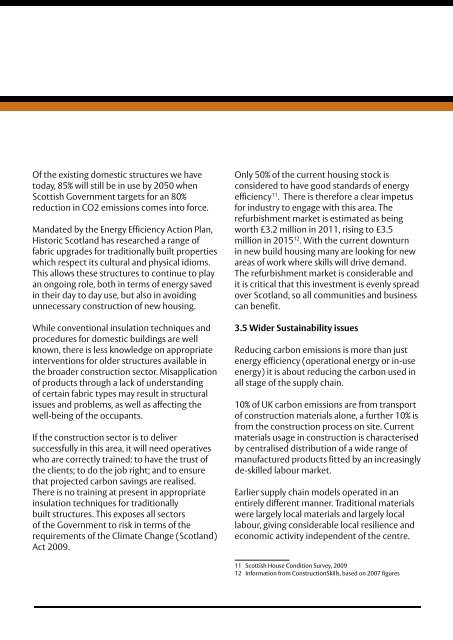Traditional Building Skills â A Strategy For ... - Historic Scotland
Traditional Building Skills â A Strategy For ... - Historic Scotland
Traditional Building Skills â A Strategy For ... - Historic Scotland
Create successful ePaper yourself
Turn your PDF publications into a flip-book with our unique Google optimized e-Paper software.
Of the existing domestic structures we have<br />
today, 85% will still be in use by 2050 when<br />
Scottish Government targets for an 80%<br />
reduction in CO2 emissions comes into force.<br />
Mandated by the Energy Efficiency Action Plan,<br />
<strong>Historic</strong> <strong>Scotland</strong> has researched a range of<br />
fabric upgrades for traditionally built properties<br />
which respect its cultural and physical idioms.<br />
This allows these structures to continue to play<br />
an ongoing role, both in terms of energy saved<br />
in their day to day use, but also in avoiding<br />
unnecessary construction of new housing.<br />
While conventional insulation techniques and<br />
procedures for domestic buildings are well<br />
known, there is less knowledge on appropriate<br />
interventions for older structures available in<br />
the broader construction sector. Misapplication<br />
of products through a lack of understanding<br />
of certain fabric types may result in structural<br />
issues and problems, as well as affecting the<br />
well-being of the occupants.<br />
If the construction sector is to deliver<br />
successfully in this area, it will need operatives<br />
who are correctly trained: to have the trust of<br />
the clients; to do the job right; and to ensure<br />
that projected carbon savings are realised.<br />
There is no training at present in appropriate<br />
insulation techniques for traditionally<br />
built structures. This exposes all sectors<br />
of the Government to risk in terms of the<br />
requirements of the Climate Change (<strong>Scotland</strong>)<br />
Act 2009.<br />
Only 50% of the current housing stock is<br />
considered to have good standards of energy<br />
efficiency 11 . There is therefore a clear impetus<br />
for industry to engage with this area. The<br />
refurbishment market is estimated as being<br />
worth £3.2 million in 2011, rising to £3.5<br />
million in 2015 12 . With the current downturn<br />
in new build housing many are looking for new<br />
areas of work where skills will drive demand.<br />
The refurbishment market is considerable and<br />
it is critical that this investment is evenly spread<br />
over <strong>Scotland</strong>, so all communities and business<br />
can benefit.<br />
3.5 Wider Sustainability issues<br />
Reducing carbon emissions is more than just<br />
energy efficiency (operational energy or in-use<br />
energy) it is about reducing the carbon used in<br />
all stage of the supply chain.<br />
10% of UK carbon emissions are from transport<br />
of construction materials alone, a further 10% is<br />
from the construction process on site. Current<br />
materials usage in construction is characterised<br />
by centralised distribution of a wide range of<br />
manufactured products fitted by an increasingly<br />
de-skilled labour market.<br />
Earlier supply chain models operated in an<br />
entirely different manner. <strong>Traditional</strong> materials<br />
were largely local materials and largely local<br />
labour, giving considerable local resilience and<br />
economic activity independent of the centre.<br />
11 Scottish House Condition Survey, 2009<br />
12 Information from Construction<strong>Skills</strong>, based on 2007 figures












![Elgin Cathedral Wedding Brochure [pdf, 544kb] - Historic Scotland](https://img.yumpu.com/22301571/1/190x151/elgin-cathedral-wedding-brochure-pdf-544kb-historic-scotland.jpg?quality=85)




